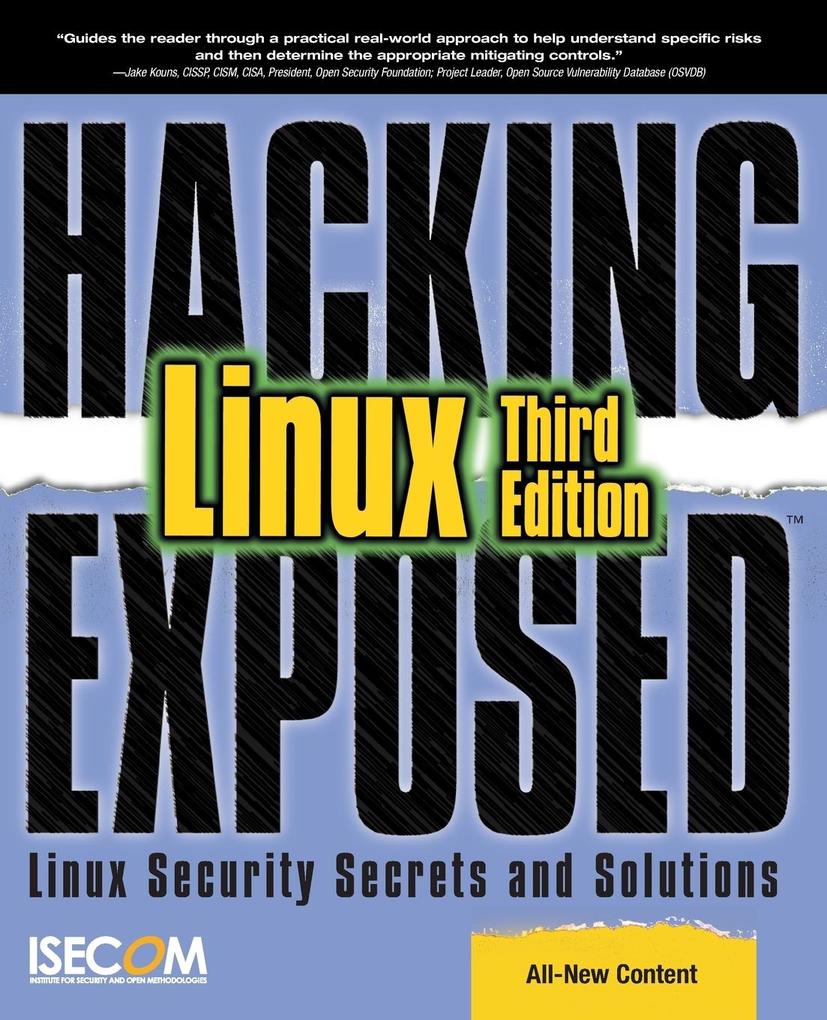
Zustellung: Di, 17.06. - Fr, 20.06.
Versand in 6 Tagen
VersandkostenfreiBestellen & in Filiale abholen:
Based on the new Linux 2.6 kernel, this edition is written from scratch by a global team of open source Linux security experts. This edition of "Hacking Exposed Linux" reveals brand-new Linux attacks, countermeasures, and case studies. The book is platform independent, so you will be able to learn how to secure any version of Linux that you are running.
Publisher's Note: Products purchased from Third Party sellers are not guaranteed by the publisher for quality, authenticity, or access to any online entitlements included with the product.
The Latest Linux Security Solutions
This authoritative guide will help you secure your Linux network--whether you use Linux as a desktop OS, for Internet services, for telecommunications, or for wireless services. Completely rewritten the ISECOM way, Hacking Exposed Linux, Third Edition provides the most up-to-date coverage available from a large team of topic-focused experts. The book is based on the latest ISECOM security research and shows you, in full detail, how to lock out intruders and defend your Linux systems against catastrophic attacks.
The Latest Linux Security Solutions
This authoritative guide will help you secure your Linux network--whether you use Linux as a desktop OS, for Internet services, for telecommunications, or for wireless services. Completely rewritten the ISECOM way, Hacking Exposed Linux, Third Edition provides the most up-to-date coverage available from a large team of topic-focused experts. The book is based on the latest ISECOM security research and shows you, in full detail, how to lock out intruders and defend your Linux systems against catastrophic attacks.
- Secure Linux by using attacks and countermeasures from the latest OSSTMM research
- Follow attack techniques of PSTN, ISDN, and PSDN over Linux
- Harden VoIP, Bluetooth, RF, RFID, and IR devices on Linux
- Block Linux signal jamming, cloning, and eavesdropping attacks
- Apply Trusted Computing and cryptography tools for your best defense
- Fix vulnerabilities in DNS, SMTP, and Web 2. 0 services
- Prevent SPAM, Trojan, phishing, DoS, and DDoS exploits
- Find and repair errors in C code with static analysis and Hoare Logic
Inhaltsverzeichnis
Foreword
Acknowledgments
Introduction
Part I: Security and Controls
Chapter 1. Applying Security
Chapter 2. Applying Interactive Controls
Chapter 3. Applying Process Controls
Part II: Hacking the System
Chapter 4. Local Access Control
Chapter 5. Data Networks Security
Chapter 6. Unconventional Data Attack Vectors
Chapter 7. Voice over IP
Chapter 8. Wireless Networks
Chapter 9. Input/Output Devices
Chapter 10. RFID--Radio Frequency Identification
Chapter 11. Emanation Attacks
Chapter 12. Trusted Computing
Part III: Hacking the Users
Chapter 13. Web Application Hacking
Chapter 14. Mail Services
Chapter 15. Name Services
Part IV: Care and Maintenance
Chapter 16. Reliability: Static Analysis of C Code
Chapter 17. Security Tweaks in the Linux Kernal
Part V: Appendixes
Appendix A. Management and Maintenance
Appendix B. Linux Forensics and Data Recovery
Appendix C. BSD
Index
Acknowledgments
Introduction
Part I: Security and Controls
Chapter 1. Applying Security
Chapter 2. Applying Interactive Controls
Chapter 3. Applying Process Controls
Part II: Hacking the System
Chapter 4. Local Access Control
Chapter 5. Data Networks Security
Chapter 6. Unconventional Data Attack Vectors
Chapter 7. Voice over IP
Chapter 8. Wireless Networks
Chapter 9. Input/Output Devices
Chapter 10. RFID--Radio Frequency Identification
Chapter 11. Emanation Attacks
Chapter 12. Trusted Computing
Part III: Hacking the Users
Chapter 13. Web Application Hacking
Chapter 14. Mail Services
Chapter 15. Name Services
Part IV: Care and Maintenance
Chapter 16. Reliability: Static Analysis of C Code
Chapter 17. Security Tweaks in the Linux Kernal
Part V: Appendixes
Appendix A. Management and Maintenance
Appendix B. Linux Forensics and Data Recovery
Appendix C. BSD
Index
Produktdetails
Erscheinungsdatum
15. Juli 2008
Sprache
englisch
Auflage
3. Auflage
Seitenanzahl
650
Autor/Autorin
Isecom
Verlag/Hersteller
Produktart
kartoniert
Gewicht
1194 g
Größe (L/B/H)
235/191/35 mm
ISBN
9780072262575
Entdecken Sie mehr
Bewertungen
0 Bewertungen
Es wurden noch keine Bewertungen abgegeben. Schreiben Sie die erste Bewertung zu "Hacking Exposed Linux" und helfen Sie damit anderen bei der Kaufentscheidung.









